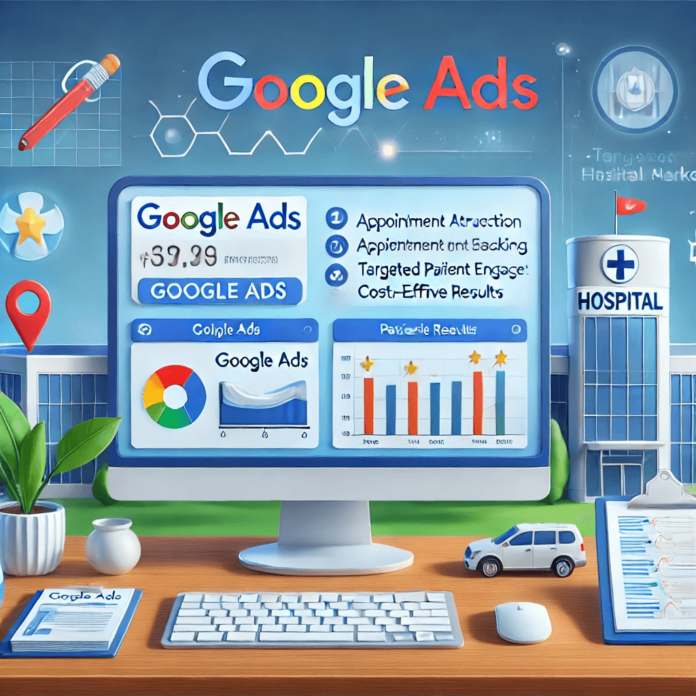Introduction
- Google Ads for Patient Acquisition: A Powerful Strategy for Hospitals
- 1. Instant Visibility in Search Results
- 2. Targeted Advertising to Reach the Right Patients
- 3. Cost-Effective Patient Acquisition with PPC
- 4. Increased Appointments and Patient Engagement
- 5. Improved Tracking and Measurable Results
- 6. Competitive Advantage in the Healthcare Industry
- 7. Personalized and Relevant Ad Campaigns
- 8. Building Trust and Credibility with Patients
- 1. Instant Visibility in Search Results
- Conclusion
In the ever-evolving healthcare industry, Google Ads for patient acquisition has become a crucial tool for hospitals looking to attract more patients and expand their reach. With the right hospital advertising solutions, healthcare providers can leverage digital marketing for hospitals to appear at the top of search results when potential patients seek medical services. Whether it’s increasing brand awareness or generating PPC patient leads, Google Ads provides targeted, cost-effective strategies that help hospitals connect with the right audience at the right time.
Google Ads for Patient Acquisition: A Powerful Strategy for Hospitals

Hospitals today face increasing competition, making it crucial to adopt digital strategies like Google Ads for patient acquisition to attract and retain patients effectively. Google Ads allows healthcare providers to connect with individuals actively searching for medical services, ensuring that their facility is visible when patients need it most.
1. Instant Visibility in Search Results
One of the most significant advantages of Google AdWords is the instant visibility it provides for hospitals. Unlike organic search efforts, which take time to yield results, AdWords places your hospital’s services at the top of search results immediately. This ensures that potential patients see your hospital when they search for relevant healthcare services, such as “emergency room near me” or “best cardiologist in [city].”
Benefits of Instant Visibility:
- Ads appear above organic search results, ensuring more clicks.
- Competing with other hospitals in your area becomes easier.
- Increased brand awareness and credibility among potential patients.
Example:
A hospital specializing in orthopedic care can appear at the top when a user searches for “knee replacement surgery near me,” increasing the chances of attracting new patients.
2. Targeted Advertising to Reach the Right Patients
Google AdWords offers powerful targeting features that allow hospitals to focus their advertising efforts on the right audience. Instead of displaying ads to a broad audience, AdWords enables hospitals to target potential patients based on location, demographics, and search intent.
Effective Targeting Options for Hospitals:
- Location Targeting: Focus on specific geographic areas to attract local patients.
- Demographic Targeting: Reach specific age groups, genders, or income levels based on healthcare needs.
- Keyword Targeting: Use healthcare-related search terms to attract patients searching for specific treatments.
Pro Tip:
Utilize geo-targeting to advertise within a certain radius of your hospital, ensuring ads reach patients who are most likely to visit your facility.
3. Cost-Effective Patient Acquisition with PPC
Google AdWords follows a pay-per-click (PPC) model, meaning hospitals only pay when a potential patient clicks on their ad. This makes AdWords a cost-effective solution compared to traditional advertising channels such as TV or print media.
Why PPC Is Cost-Effective for Hospitals:
- Flexible budget options allow hospitals to control their spending.
- Ad spending is allocated to highly targeted leads, reducing waste.
- The ability to track spending and ROI ensures financial efficiency.
Example:
A hospital promoting flu shots can set a budget cap and only pay for clicks from users searching for “flu vaccination near me,” avoiding unnecessary ad spend.
4. Increased Appointments and Patient Engagement
AdWords campaigns are designed to encourage immediate action, which is crucial for healthcare providers. Hospitals can utilize features such as click-to-call extensions, online appointment scheduling, and map integrations to make it easier for potential patients to take the next step.
How AdWords Increases Patient Engagement:
- Call extensions allow patients to contact the hospital directly from search results.
- Appointment links encourage users to book consultations online.
- Location extensions provide directions to the hospital, driving foot traffic.
Pro Tip:
Use call extensions during peak hours when appointment bookings are most likely to occur.
5. Improved Tracking and Measurable Results
Unlike traditional marketing methods, Google AdWords offers detailed analytics that allows hospitals to measure the effectiveness of their campaigns. This enables healthcare marketers to track key performance metrics (KPIs) and optimize campaigns for better results.
Essential AdWords Metrics to Track:
- Click-Through Rate (CTR): Measures how many users clicked on the ad compared to how many saw it.
- Conversion Rate: Tracks how many ad clicks led to actions such as calls or appointment bookings.
- Cost-Per-Click (CPC): This helps measure how efficiently your budget is being spent.
Pro Tip:
Regularly analyze campaign data and make adjustments to improve conversion rates and reduce cost per acquisition.
6. Competitive Advantage in the Healthcare Industry
With an increasing number of healthcare providers investing in digital marketing, hospitals must adopt AdWords to remain competitive. By investing in AdWords, hospitals can:
- Outrank competitors in search results.
- Gain better visibility for high-demand services.
- Attract patients searching for specialized treatments.
Example:
A hospital offering advanced cancer treatment can run an AdWords campaign targeting users searching for “oncology specialists near me,” ensuring they appear ahead of competing hospitals.
7. Personalized and Relevant Ad Campaigns
AdWords allows hospitals to create highly personalized ad campaigns that speak directly to potential patients’ needs. By using targeted ad copy and landing pages tailored to specific services, hospitals can increase engagement and trust.
Best Practices for Personalization:
- Use ad copy that highlights unique services and patient benefits.
- Implement dynamic keyword insertion to match user queries.
- Customize landing pages to reflect the advertised service.
Example:
An eye care center can run a campaign highlighting “LASIK eye surgery with a free consultation,” directing users to a landing page that provides more details and a booking option.
8. Building Trust and Credibility with Patients
Patients are more likely to choose a hospital that appears consistently in search results and has a strong online presence. AdWords helps hospitals build trust by:
- Displaying patient testimonials and positive reviews within ads.
- Offering valuable content like healthcare tips and services.
- Showcasing awards and accreditations to enhance credibility.
Pro Tip:
Leverage Google My Business integration to display verified patient reviews alongside ads to increase trustworthiness.
Conclusion
Investing in Google AdWords for patient acquisition is no longer an option but a necessity for hospitals looking to stay competitive and accessible in the digital age. From increasing visibility and engagement to targeting the right patients and optimizing marketing budgets, AdWords provides a powerful tool to attract more patients efficiently.
By implementing targeted campaigns, tracking performance, and leveraging AdWords’ many features, hospitals can grow their patient base and improve overall healthcare access for their communities. Now is the time to invest in Google AdWords and take your hospital’s online presence to the next level.














